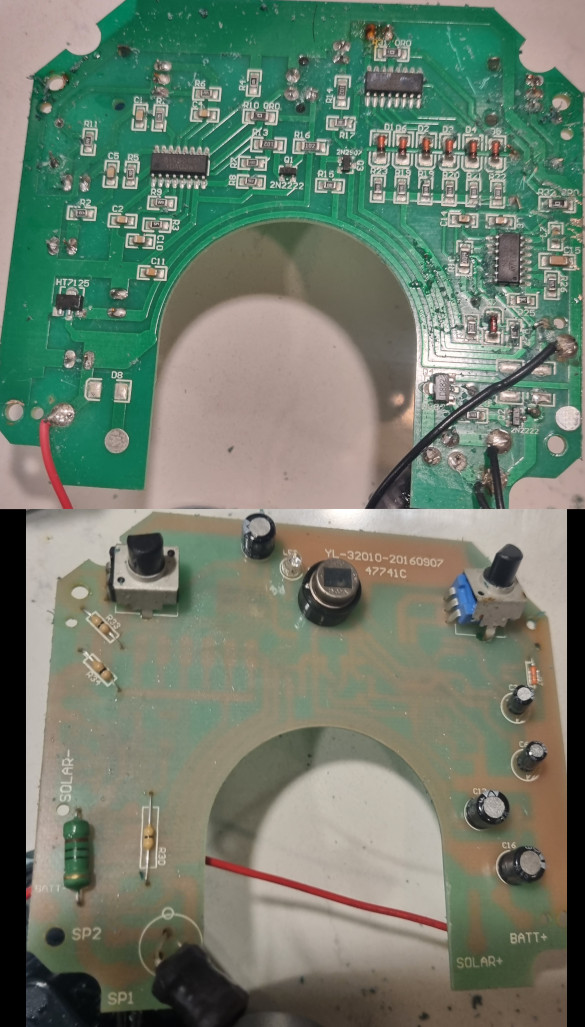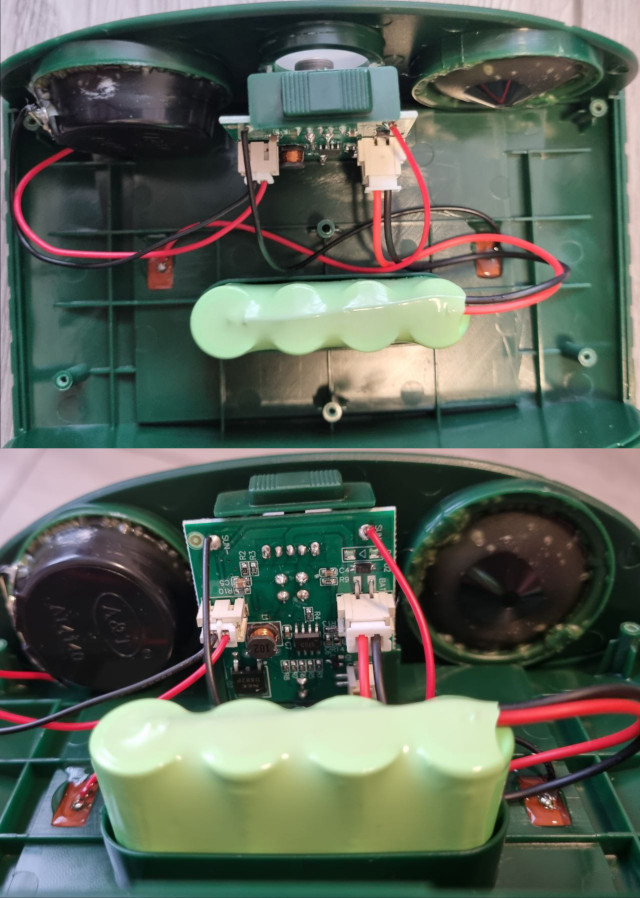Back to Silas S. Brown's home page
Cat scarers becoming audible
When we moved into a house whose garden was frequently visited by defecating cats, the sellers left us a couple of ultrasonic cat repellers (they looked like PestBye's product) which seemed to be effective for a while, but then a younger guest said she could hear the sound, and a few months later we could hear the sound as well. As we weren't expecting our hearing sensitivity to be ageing in reverse, we looked for a failure mode that brings the cat-scarer's sound back down into human hearing range as the device gets older.It turns out there is such a failure mode:
- Most electronic cat deterrents are based on a piezoelectric buzzer driven by an oscillating voltage, which usually means there'll be a resistor-capacitor (RC) oscillator somewhere in the circuit.
- To picture how an RC oscillator works, imagine taking the output of an amplifier, delaying it so there's a phase shift, and feeding the inverse of this back to the input---so after the output has gone up for a while, the input starts to be pulled down, and then after it's gone down for a while, it starts to be pulled back up, and so on. (In a real physics paper you'll want a more mathematical approach than that, but that's basically what's happening---except usually we don't bother to separately invert the feedback signal but just use an inverting amplifier.)
- In these circuits, the capacitor is key to the delay: it takes time to charge and discharge through a resistor (usually a variable resistor so you have some control over the frequency). But we're not just talking about charging up once with time constant RC---this circuit is oscillating, so at some point "capacitive reactance" will come into play. That quantity is inversely proportional to capacitance, which means bigger capacitors give us shorter delays and higher frequencies (which is not the way around we might expect from the simpler RC situation).
- The nature of capacitance loss depends on the type of capacitor. All ceramic capacitors undergo a logarithmic reduction in dielectric constant, and thus capacitance, over time (unless heated back up to its Curie point, but don't try this unless directed by the component manufacturer because you don't know what other material is in that package). But this is usually something like a 6% loss in capacitance in the first 10 years, and I'd expect that to reduce the pitch by little more than a semitone. Electrolytic capacitors can be worse due to oxide degeneration---typical 10% loss over 5 years at room temperature---but more than that was happening here. In a 2018 preprint published by the National Renewable Energy Laboratory, Gupta et al pointed to the effect of high humidity on metalised film capacitors---they corrode from the outside in and eventually fail---whereas electrolytic failure tends to come from temperature or excess use. The latter will depend on the quality of the circuit.
After cutting into one of our cat scarers with a small saw (which generated rather a lot of plastic dust and is not to be recommended), we were able to observe its circuit board.
 Apparently, it had been made 7 years earlier in 2016, had no country of origin declared, and somebody couldn't spell "sensor" but never mind. The circuit had connectors for solar input (but that wasn't fitted on this device), and legible components included
a BISS0001 PIR controller chip,
an HT7125 low-dropout voltage regulator,
an NE556 timer chip (for keeping the alarm on after motion is detected),
and D882 and 2N2222 amplifying transistors.
As I'd suspected, the oscillator was not on an IC but was made of discrete components, and the biggest capacitors were 2 x 22 micro-farad and 3 x 220 micro-farad cylindrical electrolytic, with possibly some smaller ceramic chip capacitors as well (it was hard to see exactly).
There were also signs of water ingress, possibly due to the rubber seal around the battery holder not being properly refitted after changing the batteries.
Apparently, it had been made 7 years earlier in 2016, had no country of origin declared, and somebody couldn't spell "sensor" but never mind. The circuit had connectors for solar input (but that wasn't fitted on this device), and legible components included
a BISS0001 PIR controller chip,
an HT7125 low-dropout voltage regulator,
an NE556 timer chip (for keeping the alarm on after motion is detected),
and D882 and 2N2222 amplifying transistors.
As I'd suspected, the oscillator was not on an IC but was made of discrete components, and the biggest capacitors were 2 x 22 micro-farad and 3 x 220 micro-farad cylindrical electrolytic, with possibly some smaller ceramic chip capacitors as well (it was hard to see exactly).
There were also signs of water ingress, possibly due to the rubber seal around the battery holder not being properly refitted after changing the batteries.
Thinking that mains or solar cat scarers might be less likely to be damaged in this way over time than battery-powered ones (because the event of changing the batteries is a time when things can go wrong), I replaced it with an unbranded solar-powered cat scarer bought online.
 This one turned out to be easier to get into with a small Philips screwdriver: it had a faux second speaker for graphic design, a D882P power transistor, a small transformer (I think), and an 8-pin "510D" chip which I'm guessing is a battery charge regulator but it's hard to make out the oscillator circuit. The seller incorrectly described it as having adjustable sensitivity (5 modes)---it does not, which meant we had no way to adjust it when it started triggering almost continuously (which is less effective) a few weeks after purchase (returns not accepted). There is an unconnected third socket on the circuit board which might have been meant for a control but it wasn't clear. The manufacturing date was given as 2022-10-15.
This one turned out to be easier to get into with a small Philips screwdriver: it had a faux second speaker for graphic design, a D882P power transistor, a small transformer (I think), and an 8-pin "510D" chip which I'm guessing is a battery charge regulator but it's hard to make out the oscillator circuit. The seller incorrectly described it as having adjustable sensitivity (5 modes)---it does not, which meant we had no way to adjust it when it started triggering almost continuously (which is less effective) a few weeks after purchase (returns not accepted). There is an unconnected third socket on the circuit board which might have been meant for a control but it wasn't clear. The manufacturing date was given as 2022-10-15.
Any circuit may eventually be vulnerable, and having the frequency reduced to a level that at least some humans can hear seems to be a common failure mode causing many complaints about neighbours' cat scarers, so it's probably important to ensure they're still in good condition and this frequency-reduction failure hasn't happened.
(We stopped maintaining cat scarers after our local cats were rehoused: it turned out their previous human had been unable to provide them with litter, and fixing that solved the problem.)
Copyright and Trademarks
All material © Silas S. Brown unless otherwise stated.Any trademarks I mentioned without realising are trademarks of their respective holders.